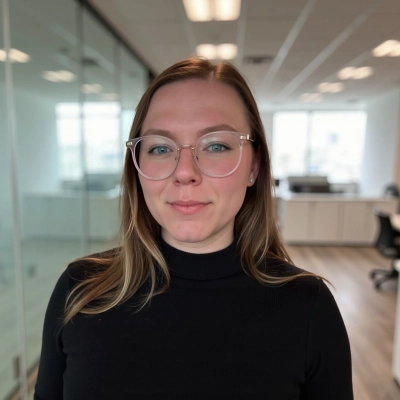17 Expert Tips for Optimizing Website Content for User Intent
Discover expert strategies to enhance your website's content and align it with user intent. This comprehensive guide offers insights from industry professionals on optimizing your online presence. Learn how to create engaging, user-focused content that drives meaningful actions and improves overall website performance.
- Map Content to User Journey Stages
- Create a Content Pyramid for Engagement
- Guide Users to Take Meaningful Actions
- Adopt a Conversational Tone in Writing
- Address User Questions Directly and Concisely
- Provide Rich Cultural Context for Experiences
- Target Stressed-Out Moments in Legal Content
- Align Content with Search Engine Results
- Optimize for Both Users and AI Parsability
- Focus on Solving Customer Problems Directly
- Use Search Console to Improve Engagement
- Lead with Answers and Calls to Action
- Listen to Users and Adapt Content Regularly
- Pair Cultural Insight with Clear CTAs
- Incorporate Related Questions into Content
- Showcase Relevant Examples for Immediate Clarity
- Analyze User Behavior Data
Map Content to User Journey Stages
My approach to user intent optimization has evolved significantly over 30 years in SEO, especially since Google's algorithms became sophisticated enough to understand what people actually want, not just what keywords they type.
The biggest shift in my thinking came when I realized that user intent isn't just about matching search queries — it's about understanding the complete user journey and what someone needs to accomplish at each stage. Most businesses optimize for keywords when they should be optimizing for problems and solutions.
Here's my most effective strategy: I call it "Intent Mapping Through Real User Behavior." Instead of guessing what users want, I analyze actual user behavior data from Google Search Console and SE Ranking to see how people interact with our content after they find it.
My key tip based on experience: Create content that serves the next logical question, not just the current search query. When someone searches "what is SEO," they don't just want a definition — they want to know if SEO will help their specific business situation. Our "What Is SEO in 2025?" guide doesn't just explain SEO; it addresses the follow-up questions about cost, timeline, and whether it's worth the investment.
This is where our Micro SEO methodology really shines. Instead of creating broad content that tries to serve everyone, we create comprehensive content that serves specific user scenarios. A local business owner searching for SEO information has completely different intent than an enterprise marketing manager, even if they use similar keywords.
The practical implementation involves structuring content with clear sections that address different intent levels. Our SEO pricing guide has quick pricing tables for people who just want numbers, detailed explanations for those who need to understand methodology, and comparison sections for people evaluating different agencies.
The measurement approach focuses on engagement metrics that indicate intent satisfaction — time on page, scroll depth, and most importantly, conversion actions. When our content properly matches intent, people don't just visit; they take meaningful next steps like downloading resources or contacting us.

Create a Content Pyramid for Engagement
What has worked best for me and my Web3 SEO agency is treating content like a pyramid rather than a flat list of topics. Around one-fifth of our efforts go into decision-focused assets such as comparisons, buying guides, and ICP-specific solutions. These sit at the base, aimed at people who already have intent and just need that final nudge. From there, we layer educational material on top: explainers, thought leadership, and practical guides that bring in earlier-stage users while also strengthening topical authority.
With a crypto payments client, this structure paid off in two ways. Conversion rates climbed thanks to the product-led content, while the educational pieces steadily pulled in organic traffic and funneled curious readers into those decision-making paths. By addressing both ends of the journey—browsers and buyers—we managed to grow traffic and revenue at the same time.

Guide Users to Take Meaningful Actions
The most effective way to optimize website content for user intent is to map every piece of content to the action a searcher actually wants to take, not just the keywords they use. Search engines have become excellent at interpreting intent, so your content needs to answer the real question behind the query.
For example, I worked with a SaaS client whose blog posts ranked well but weren't converting. The issue was that the content explained "what" something was but didn't help readers move to the next step. We restructured those articles to include practical next actions—like product demos, comparison charts, and clear CTAs—which aligned with the transactional intent of their search. Within six weeks, those same pages generated 18% more sign-ups.
The key insight is this: don't just provide information, guide users seamlessly toward the action they came looking to take.

Adopt a Conversational Tone in Writing
My approach to optimizing content for user intent centers on making the experience feel natural and engaging for visitors. I learned this firsthand when working on a blog for a small firm where the original content read like a lecture. We shifted the tone to be more conversational, and the results were immediate - the bounce rate dropped significantly because readers felt more connected to the content. The key insight was that users don't just want information; they want it delivered in a way that feels like a genuine conversation rather than being talked at. This simple change in tone made the content much more aligned with what users were actually looking for when they landed on the page.
Address User Questions Directly and Concisely
What has worked for us in optimizing website content is treating it the same way we approach our social content: answer the user's question upfront, without fluff.
If someone lands on our article searching "Should I hire an in-house designer or a design agency?", we don't waste time with background or theory. Instead, we start by addressing the tradeoffs directly, then expand into examples, numbers, and context further down.
This approach has made our content feel immediately useful and non-salesy, aligning with how buyers actually make decisions.
In my experience, removing friction like this matters far more than keyword stuffing or volume; the content has to solve the intent right from the top.

Provide Rich Cultural Context for Experiences
My approach is to start by mapping every page to the question a visitor is really asking. If someone searches "best project management software," they don't want a history lesson—they want comparisons, pros and cons, and a clear next step. One tip: scan the search results for that query and note the patterns in what Google is surfacing—lists, how-tos, reviews. Then structure your content to match that intent but add something extra (unique data, sharper examples, or a clearer CTA) so it stands out.

Target Stressed-Out Moments in Legal Content
Ensuring content meets user intent requires us to produce rich experience descriptions that cater to the exact research process undertaken by travelers who spend a disproportionate amount of time looking into the cultural authenticity of an experience before booking it. When we analyzed our pages with the highest conversion rate, we saw visitors were spending more than 6 minutes consuming macro content like guide biographies, neighborhood histories, and workshop content. This revelation led us to doubling down on the depth of our content rather than diluting it for quick consumption, and ultimately we saw a 35% lift in conversion among travelers who had an appetite for deep cultural context that helped our travelers understand why our pricing was at a premium.
My gut-feeling advice is to create content hierarchies to service both the impatient scan reader looking for gist and the detailed culturephile wanting the lowdown. This can be through collapsible sections or even on separate subpages from primary experience descriptions. We provided incremental content gating where the first open level content shares need-to-know workshop details, and every "learn more" provides deep guide backgrounds, cultural historical context, and traveler learning history for their destination; all the elements devout cultural purists require when judging an authentic experience. It's critical to balance and service multi-faceted user intent within a single page rather than assuming all are seeking the same depth in information. And being aware that travelers, already investing time in their education on the culture, often take the time to thoroughly research offerings before opting for anything genuine - is important.
Maximizing the value for both the fast-track to immediate help, with more in-depth cultural context available for visitors who are ready to invest in a deeper, more meaningful experience.

Align Content with Search Engine Results
As someone who has helped more than 85 law firms increase their caseloads through SEO, I've learned that optimizing for user intent isn't about stuffing keywords; it's about understanding what keeps your target audience awake at night.
We build every piece of content around the question: "What would a potential client Google at their most stressed-out moment?" For a criminal defense firm, that's not "legal defense strategies," but rather "Will I go to jail for a first DUI in Georgia?" Matching that emotional, real-world intent is the difference between a bounce and a booked consultation.
Our team builds SEO strategies specifically for law firms, so we obsess over the nuances of intent, from "just browsing" to "I need help right now." One simple tip: use your intake calls as content goldmines. If clients keep asking the same question, that's your next headline.

Optimize for Both Users and AI Parsability
Great question! From my experience, the best way to optimize website content for user intent is to start by understanding why someone is searching in the first place. Today, search engines are smarter than ever, and users expect precise answers fast. I usually begin with intent mapping—categorizing keywords into informational, navigational, and transactional. This helps me match the right type of content with what the user truly wants.
One practical tip I use is reviewing SERP features before writing. For example, if a keyword shows FAQs, videos, or comparison tables, I build those formats directly into my content. This not only aligns with user expectations but also increases visibility. I also keep content structured with clear headings, scannable sections, and examples because most users skim before they decide to read deeper.
Finally, I don't just publish and forget. I monitor metrics like dwell time, click-through rate, and scroll depth to see if the content is meeting intent. If people bounce quickly, I revisit and refine. In short, optimizing for user intent is about blending research, content structure, and continuous improvement so the content feels helpful, human, and relevant.

Focus on Solving Customer Problems Directly
My approach to optimizing website content for user intent starts with mapping content to the buyer's journey. If someone is problem-aware, they need education and clarity. If they're solution-aware, they need comparisons and proof. If they're purchase-ready, they need speed, trust signals, and a clear CTA. Aligning copy and structure to these different stages ensures the visitor always feels "understood."
But here's the curveball: in 2025 and beyond, optimizing only for user intent isn't enough. The bigger game is optimizing for AI parsability. Search engines and AI assistants will soon be the real "first readers" of your content, and often they'll transact on a buyer's behalf without the user even visiting your site. That means structured data, clear schema, FAQs, and machine-readable content are now just as critical as persuasive copy. If your site isn't AI bot friendly, you risk being invisible in the buying journey because increasingly, the purchase won't even happen on your website, it'll happen inside the AI box. The other problem is who hosts your site, as a lot of these web-building platforms have bots blocked on their shared servers.

Use Search Console to Improve Engagement
When optimizing website content for user intent, I've found success by shifting focus from company-centric messaging to addressing customer problems directly. Your content should speak to your visitors' specific challenges, fears, and frustrations. This customer-first approach resonates more deeply than simply talking about your organization.
Once you've connected with users by acknowledging their pain points, demonstrate precisely how your product or service solves these issues. Complete the optimization process by ensuring your site makes it effortless for visitors to contact you and complete purchases. Clear pathways to conversion are just as important as the content itself when aligning with user intent.
Lead with Answers and Calls to Action
I regularly use Google Search Console's Performance tab to identify opportunities for intent optimization. My approach focuses on finding keywords that generate high impressions but low click-through rates, as this indicates a mismatch between content and user intent. Once identified, I strategically revise page titles and meta descriptions to better align with what users are actually searching for. This data-driven method has consistently improved engagement metrics across our website properties.

Listen to Users and Adapt Content Regularly
Begin with a two-sentence answer and a call to action like 'Do this next', then give details in accordions. For a have-to-have-it-now head-to-head comparison page we shipped a 2-line verdict box ('Best for X / Best for Y') and one call to action ('Try a 30-sec fit check'); bounce down 22% and qualified clicks to trial up 27%. As a co-founder at all-in-one-ai.co, I've seen this answer-first approach consistently outperform long introductions because it delivers - 'I-need-it-now' intent - before it sells.
My recommendation would be - write the first 100 words as the answer + next step, set the above-the-fold copy to ~150 words, move spec/pricing blocks to accordions, and track the p75 click to call to action - if it's under 20% then tighten the lead, don't add more content.
Glad to provide more information on what we do if that's helpful.
Website: https://all-in-one-ai.co/
LinkedIn: https://www.linkedin.com/in/dario-ferrai/
Headshot:
https://drive.google.com/file/d/1i3z0ZO9TCzMzXynyc37XF4ABoAuWLgnA/view?usp=sharing
Bio: I'm the Chief Marketing Officer of all-in-one-AI.co. I build AI tooling and infrastructure with security-first development workflows and scaling LLM workload deployments.
Best,
Dario Ferrai

Pair Cultural Insight with Clear CTAs
Content optimization works differently for every business, as it depends entirely on its target audience. What worked great for me is listening to the user rather than jumping directly into keywords or design.
One practical tip that has always helped is reviewing search queries in Google Search Console and talking directly with sales teams or customer support. This way, I was able to learn the real questions users ask, which sometimes never show up in keyword tools. I then started creating content that addresses the users' queries. Following this approach has improved my rankings and brought in organic traffic.
Lastly, my tip is to never assume intent is fixed. Review your analytics monthly, talk with your teams, and refresh content to match your users' needs over time.

Incorporate Related Questions into Content
Our approach to optimizing content always starts with user intent over keywords. At Ranked, we ask: What is this person really trying to accomplish when they land here? Then we design the page to answer that question quickly and clearly.
One tip from our experience: pair cultural insight with clear calls to action. For example, when we worked on creator-driven campaigns, we aligned landing pages to reflect the same language and themes creators used in their posts. That consistency boosted engagement and conversions because the experience felt seamless.
Showcase Relevant Examples for Immediate Clarity
I start by mapping content to the exact stage of the user's journey—are they researching, comparing, or ready to buy? One tip that has worked well is analyzing the "People also ask" and related searches in Google, then weaving those questions and answers naturally into the page. This ensures the content speaks directly to user intent while also signaling relevance to search engines.

Analyze User Behavior Data
As a founder and CEO who's also hands-on with our content production team, I've learned that optimizing for user intent means making every piece of content feel like it was created to answer a visitor's most pressing question at the exact moment they land on our site. For example, on our explainer video service pages, we describe what we do. More than that, though, we also showcase short, context-relevant video snippets that let users instantly see our style and quality.
This way, instead of asking them to scroll through long text or guess what working with us feels like, they get immediate clarity. The goal here is twofold: reduce friction in their decision-making and show transparency that builds trust. In my experience, anticipating what the visitor is looking for and delivering it in the most direct, engaging way is the single biggest driver of both conversions and meaningful interactions.





